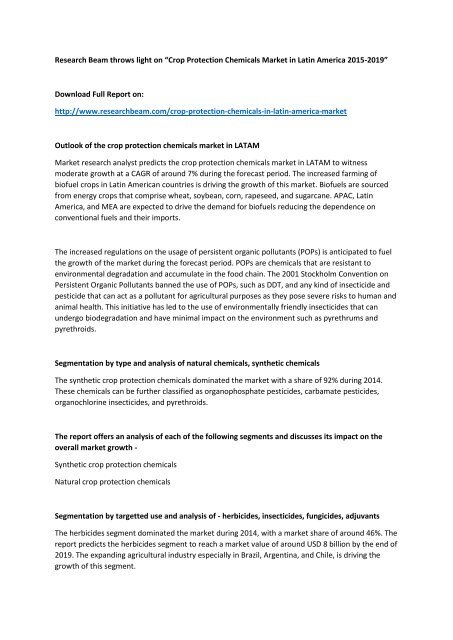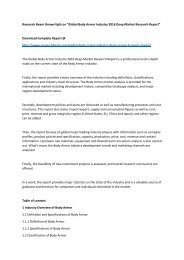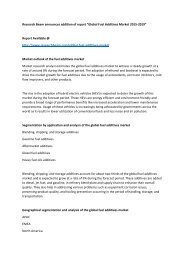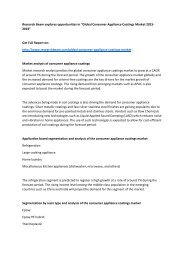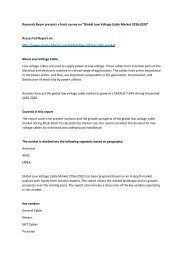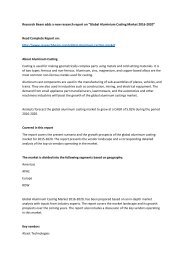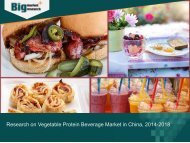Latin America Crop Protection Chemicals Market Growth 2019
Get Crop Protection Chemicals Market in Latin America with Key players, Drivers, Challenges, Trends with natural & synthetic chemicals type and analysis. Download Full Report on: http://www.researchbeam.com/crop-protection-chemicals-in-latin-america-market
Get Crop Protection Chemicals Market in Latin America with Key players, Drivers, Challenges, Trends with natural & synthetic chemicals type and analysis.
Download Full Report on:
http://www.researchbeam.com/crop-protection-chemicals-in-latin-america-market
Create successful ePaper yourself
Turn your PDF publications into a flip-book with our unique Google optimized e-Paper software.
Research Beam throws light on “<strong>Crop</strong> <strong>Protection</strong> <strong>Chemicals</strong> <strong>Market</strong> in <strong>Latin</strong> <strong>America</strong> 2015-<strong>2019</strong>”<br />
Download Full Report on:<br />
http://www.researchbeam.com/crop-protection-chemicals-in-latin-america-market<br />
Outlook of the crop protection chemicals market in LATAM<br />
<strong>Market</strong> research analyst predicts the crop protection chemicals market in LATAM to witness<br />
moderate growth at a CAGR of around 7% during the forecast period. The increased farming of<br />
biofuel crops in <strong>Latin</strong> <strong>America</strong>n countries is driving the growth of this market. Biofuels are sourced<br />
from energy crops that comprise wheat, soybean, corn, rapeseed, and sugarcane. APAC, <strong>Latin</strong><br />
<strong>America</strong>, and MEA are expected to drive the demand for biofuels reducing the dependence on<br />
conventional fuels and their imports.<br />
The increased regulations on the usage of persistent organic pollutants (POPs) is anticipated to fuel<br />
the growth of the market during the forecast period. POPs are chemicals that are resistant to<br />
environmental degradation and accumulate in the food chain. The 2001 Stockholm Convention on<br />
Persistent Organic Pollutants banned the use of POPs, such as DDT, and any kind of insecticide and<br />
pesticide that can act as a pollutant for agricultural purposes as they pose severe risks to human and<br />
animal health. This initiative has led to the use of environmentally friendly insecticides that can<br />
undergo biodegradation and have minimal impact on the environment such as pyrethrums and<br />
pyrethroids.<br />
Segmentation by type and analysis of natural chemicals, synthetic chemicals<br />
The synthetic crop protection chemicals dominated the market with a share of 92% during 2014.<br />
These chemicals can be further classified as organophosphate pesticides, carbamate pesticides,<br />
organochlorine insecticides, and pyrethroids.<br />
The report offers an analysis of each of the following segments and discusses its impact on the<br />
overall market growth -<br />
Synthetic crop protection chemicals<br />
Natural crop protection chemicals<br />
Segmentation by targetted use and analysis of - herbicides, insecticides, fungicides, adjuvants<br />
The herbicides segment dominated the market during 2014, with a market share of around 46%. The<br />
report predicts the herbicides segment to reach a market value of around USD 8 billion by the end of<br />
<strong>2019</strong>. The expanding agricultural industry especially in Brazil, Argentina, and Chile, is driving the<br />
growth of this segment.
The report offers an analysis of each of the following segments and discusses its impact on the<br />
overall market growth -<br />
Herbicides<br />
Insecticides<br />
Fungicides<br />
Adjuvants<br />
Segmentation by crop type and analysis of - cereals, oilseeds, fruits<br />
Cereals and grains accounted for nearly 46% of the overall market during 2014. The rapid change in<br />
the diet pattern of people across the world has propelled the growth of this segment.<br />
The report offers an analysis of each of the following segments and discusses its impact on the<br />
overall market growth.<br />
Cereals and grains<br />
Oilseeds and pulses<br />
Fruits and vegetables<br />
Competitive landscape and key vendors - BASF, Bayer, Dow, DuPont, Monsanto<br />
The crop protection chemicals market in LATAM is dominated by international vendors. The<br />
introduction of energy-efficient agricultural technologies in developing countries is spurring the<br />
market growth. The competitive environment in this market is expected to intensify further due to<br />
an increase in product/service extensions, technological innovations, and mergers. The report<br />
anticipates international vendors to grow inorganically by acquiring regional or local vendors during<br />
the forecast period.<br />
The leading vendors in the market are -<br />
BASF<br />
Bayer<br />
Dow<br />
DuPont<br />
Monsanto<br />
Syngenta<br />
Valent
Other prominent vendors in the market include ADAMA, Arysta LifeScience, FMC, Marrone Bio<br />
Innovations, Novozymes, Nufarm, and Sumitomo Chemical.<br />
Key questions answered in the report include<br />
What will the market size and the growth rate be in <strong>2019</strong>?<br />
What are the key factors driving the crop protection chemicals market in LATAM?<br />
What are the key market trends impacting the growth of the crop protection chemicals market in<br />
LATAM?<br />
What are the challenges to market growth?<br />
Who are the key vendors in this market space?<br />
What are the market opportunities and threats faced by the vendors in the crop protection<br />
chemicals market in LATAM?<br />
What are the key outcomes of the five forces analysis of the crop protection chemicals market in<br />
LATAM?<br />
Related reports<br />
Global <strong>Crop</strong> <strong>Protection</strong> <strong>Chemicals</strong> <strong>Market</strong> 2015-<strong>2019</strong><br />
Global Agroscience <strong>Market</strong> 2015-<strong>2019</strong><br />
Global Plant <strong>Growth</strong> Chamber <strong>Market</strong> 2015-<strong>2019</strong><br />
Potassium Nitrate <strong>Market</strong> 2015-<strong>2019</strong><br />
Global Bio-herbicides <strong>Market</strong> 2015-<strong>2019</strong><br />
Table of Content:<br />
PART 01: Executive summary<br />
Highlights<br />
PART 02: Scope of the report<br />
<strong>Market</strong> overview<br />
Top-vendor product offerings<br />
PART 03: <strong>Market</strong> research methodology
Research methodology<br />
Economic indicators<br />
PART 04: Introduction<br />
Key market highlights<br />
PART 05: Global agriculture overview<br />
Agricultural production<br />
Global agricultural land<br />
Read Further @<br />
http://www.researchbeam.com/crop-protection-chemicals-in-latin-america-market/enquireabout-report<br />
About Research Beam:<br />
Research Beam is a high end and wide online market for market research reports that contain<br />
detailed and rational market research. Research Beam is a one stop report destination that offers<br />
clients well drafted and accurately analyzed report with insightful data. Reports available on our<br />
data base are holistic in nature and will help to understand your related market effectively. Our<br />
market research reports are of the highest quality with deep dive analytical view that offer clients<br />
incisive perspective about the market. With the help of our reports, clients can easily understand the<br />
dynamic nature of their respective markets and then implement result oriented decisions. With<br />
armor of expertise and experience, Research Beam is best place to address your business research<br />
needs.<br />
Contact Us:<br />
Deep Joshi<br />
Global Head Quarters<br />
5933 NE Win Sivers Drive,<br />
#205, Portland, OR 97220<br />
United States: +1 (800) 910-6452<br />
UK: +44 845-528-1300<br />
Email: help@researchbeam.com<br />
Web: http://www.researchbeam.com/


